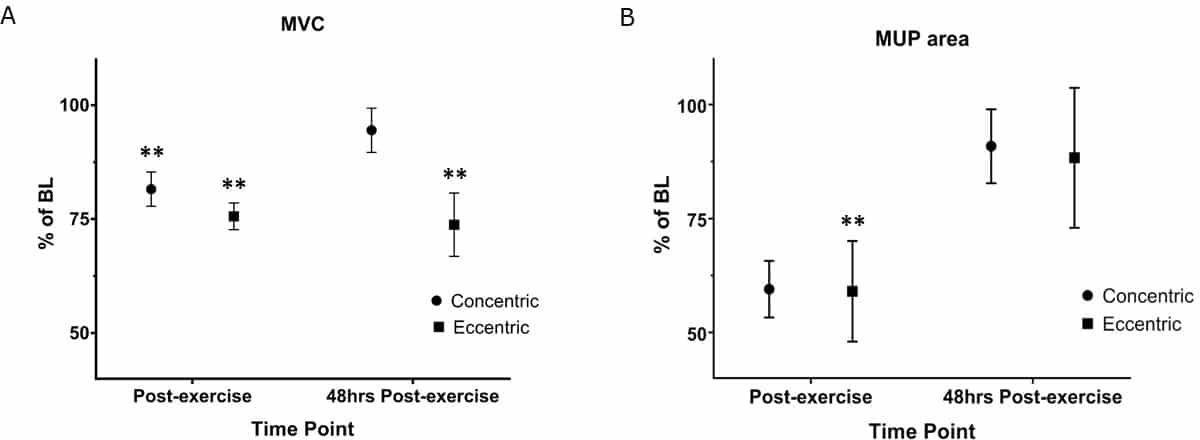Generation of muscle force relies on a combination of altered motor unit firing rates, and recruitment through a progressively increasing range of sizes. Alterations in these mechanisms may influence muscle functional decline in the fatigued and damaged state. Although eccentric exercise elicits a more significant loss of function, muscle damage and soreness than concentric, it is unclear how these forms of exercise may influence the size of MU recruited to achieve a given force (Semmler et al., 2014). We hypothesized that any functional deficits observed in muscle force-generating capacity of the quadriceps would be also observed in the size of recruited vastus lateralis motor units. The ‘Step Up, Step Down’ exercise technique (Kostek et al., 2007) was applied in 8 untrained healthy young adults (2 Male; 23±2yrs; BMI 27±6), designed to induce eccentric and concentric exercise in opposing quadriceps. Maximal voluntary isometric contraction (MVC) and serum creatine kinase were assessed as an indicator of functional decline and muscle damage, respectively. Intramuscular electromyography was used to sample individual motor units during isometric contractions held at 25% MVC, and the area of the motor unit potential was used as an indicator of motor unit size (Piasecki et al., 2018). All measures were performed at baseline, post-exercise & 48hrs post-exercise. Creatine kinase increased 26±10% from baseline (121±49 IU/L) to post-exercise (149±59 IU/L, P = 0.0471), and the mean value remained elevated at 48 hours post-exercise (165±69 IU/L, P = 0.2122) when compared to baseline. In the concentric limb, MVC was reduced immediately post-exercise (18±10% P = 0.0071), but did not differ significantly at 48 hours (13±8% P = 0.139) compared to baseline (Figure 1A). A similar pattern was observed for MUP area in the concentric limb which reduced by 40±14% (P = 0.051) immediately post-exercise, and 12±3% (P = 0.658) at 48 hours post-exercise. In the eccentric limb MVC was reduced by 24±8% immediately post-exercise (P = 0.0019), and remained significantly reduced by 26±18% (P = 0.0016) at 48 hours. However, unlike the concentric limb, the change in MUP area in the eccentric limb did not correspond with the prolonged reduction in MVC, decreasing by 41±25% (P = 0.0062) immediately post, and by 9±18% (P = 0.212) at 48 hours post-exercise, thus reverting to near baseline values (Figure 1B). The restoration of the MU size suggests that in healthy young adults the recruitment strategy can recover after a significant eccentric-exercise induced disturbance, though the recovery is not equalled by force producing ability. Changes in MUP area did not differ between the two exercise conditions, at either time points tested, whereas the expected differences in muscle function were observed. These data are highly suggestive of a minimal relevance of motor unit size recruitment strategies in the observed functional decline following eccentric exercise.
Physiology 2019 (Aberdeen, UK) (2019) Proc Physiol Soc 43, PC130
Poster Communications: Motor Unit Characteristics of the Human Vastus Lateralis following Eccentric/ Concentric induced Functional Decline
D. McCormick1, J. Gladman1, P. L. Greenhaff1, P. J. Atherton1, M. Piasecki1
1. MRC-ARUK Centre for Musculoskeletal Ageing Research & NIHR Nottingham Biomedical Research Centre, University of Nottingham, Royal Derby Hospital Centre, United Kingdom.
View other abstracts by:
Figure 1. Maximum voluntary isometric contraction (A) and motor unit potential area (B) immediately post and 48 hours post eccentric and concentric exercise
Where applicable, experiments conform with Society ethical requirements.

